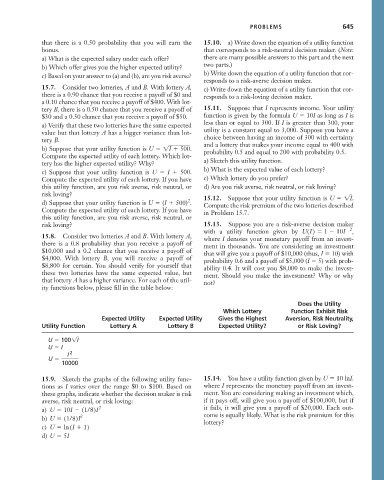Page 671 - Microeconomics, Fourth Edition
P. 671
c15riskandinformation.qxd 8/16/10 11:10 AM Page 645
PROBLEMS 645
that there is a 0.50 probability that you will earn the 15.10. a) Write down the equation of a utility function
bonus. that corresponds to a risk-neutral decision maker. (Note:
a) What is the expected salary under each offer? there are many possible answers to this part and the next
b) Which offer gives you the higher expected utility? two parts.)
c) Based on your answer to (a) and (b), are you risk averse? b) Write down the equation of a utility function that cor-
responds to a risk-averse decision maker.
15.7. Consider two lotteries, A and B. With lottery A, c) Write down the equation of a utility function that cor-
there is a 0.90 chance that you receive a payoff of $0 and responds to a risk-loving decision maker.
a 0.10 chance that you receive a payoff of $400. With lot-
tery B, there is a 0.50 chance that you receive a payoff of 15.11. Suppose that I represents income. Your utility
$30 and a 0.50 chance that you receive a payoff of $50. function is given by the formula U 10I as long as I is
a) Verify that these two lotteries have the same expected less than or equal to 300. If I is greater than 300, your
value but that lottery A has a bigger variance than lot- utility is a constant equal to 3,000. Suppose you have a
tery B. choice between having an income of 300 with certainty
and a lottery that makes your income equal to 400 with
b) Suppose that your utility function is U 1I 500. probability 0.5 and equal to 200 with probability 0.5.
Compute the expected utility of each lottery. Which lot-
tery has the higher expected utility? Why? a) Sketch this utility function.
c) Suppose that your utility function is U I 500. b) What is the expected value of each lottery?
Compute the expected utility of each lottery. If you have c) Which lottery do you prefer?
this utility function, are you risk averse, risk neutral, or d) Are you risk averse, risk neutral, or risk loving?
risk loving? 15.12. Suppose that your utility function is U 1I.
2
d) Suppose that your utility function is U (I 500) . Compute the risk premium of the two lotteries described
Compute the expected utility of each lottery. If you have in Problem 15.7.
this utility function, are you risk averse, risk neutral, or
risk loving? 15.13. Suppose you are a risk-averse decision maker
with a utility function given by U(I ) 1 10I 2 ,
15.8. Consider two lotteries A and B. With lottery A, where I denotes your monetary payoff from an invest-
there is a 0.8 probability that you receive a payoff of ment in thousands. You are considering an investment
$10,000 and a 0.2 chance that you receive a payoff of that will give you a payoff of $10,000 (thus, I 10) with
$4,000. With lottery B, you will receive a payoff of probability 0.6 and a payoff of $5,000 (I 5) with prob-
$8,800 for certain. You should verify for yourself that ability 0.4. It will cost you $8,000 to make the invest-
these two lotteries have the same expected value, but ment. Should you make the investment? Why or why
that lottery A has a higher variance. For each of the util- not?
ity functions below, please fill in the table below:
Does the Utility
Which Lottery Function Exhibit Risk
Expected Utility Expected Utility Gives the Highest Aversion, Risk Neutrality,
Utility Function Lottery A Lottery B Expected Utility? or Risk Loving?
U 1001I
U I
I 2
U
10000
15.9. Sketch the graphs of the following utility func- 15.14. You have a utility function given by U 10 lnI.
tions as I varies over the range $0 to $100. Based on where I represents the monetary payoff from an invest-
these graphs, indicate whether the decision maker is risk ment. You are considering making an investment which,
averse, risk neutral, or risk loving: if it pays off, will give you a payoff of $100,000, but if
a) U 10I (1/8)I 2 it fails, it will give you a payoff of $20,000. Each out-
b) U (1/8)I 2 come is equally likely. What is the risk premium for this
lottery?
c) U ln (I 1)
d) U 5I

